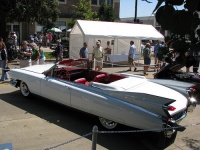Difference between revisions of "Chapter 1"
(→Page 5) |
|||
| Line 33: | Line 33: | ||
==Page 5== | ==Page 5== | ||
'''1959 Cadillac Biarritz'''<br /> | '''1959 Cadillac Biarritz'''<br /> | ||
| − | [[File:59Biarritz.jpg|thumb| | + | a luxury version of the Eldorado. [http://en.wikipedia.org/wiki/Cadillac_Eldorado Wikipedia]. |
| + | |||
| + | [[File:59Biarritz.jpg|thumb|200px|right|1959 Cadillac Biarritz, Creative Commons licensed photo from [http://www.flickr.com/photos/jacksnell707/3038759553/ here]]] | ||
==Page 12== | ==Page 12== | ||
Revision as of 15:24, 22 July 2009
- Please keep these annotations SPOILER-FREE by not revealing information from later pages in the novel.
Contents
Title
"Inherent Vice" has a number of meanings. See Inherent Vice Title
Cover
The painting on the cover is titled "Eternal Summer," by the artist Darshan Zenith. Official site. Zenith subtitles the painting "A 'Retired' Caddy Hearse Greets Daybreak at a Beach Surf Shop." Prints of the painting can be purchased here. More info at Thomaspynchon.com
Book jacket description
Pynchon himself wrote the copy to the book jacket description of Against the Day (text here). It is possible that Pynchon did the same for Inherent Vice.
Epigraph
Under the paving-stones, the beach!
"Sous les pavés, la plage" - slogan dating from the 1968 Paris student riots. Wikipedia Literally, it refers to the paving stones thrown at the police. Figuratively, it refers to the ideal life to be found beneath the confines of society.
Dedication
Like Against the Day, Inherent Vice has no dedication. Pynchon dedicated previous novels to friends and family: Mason & Dixon ("For Melanie, and for Jackson"), Vineland ("For my mother and father"), and Gravity's Rainbow ("For Richard Fariña").
Page 1
Country Joe & the Fish T-shirt
A Berkeley-based rock band most widely known for musical protests against the Vietnam War, from 1966 to 1971
Shasta
Shasta is a soft drink brand that reached the peak of its popularity in the 1980s. Wikipedia. Note that Pynchon has named characters after soda before, e.g. Wicks Cherrycoke in Mason & Dixon.
Shasta is also the name of a town in northern California, near Redding. Google Maps
They stood in the street light through the kitchen window there'd never been much point in putting curtains over and listened to the thumping of the surf from down the hill. Some nights, when the wind was right, you could hear the surf all over town.
Like Vineland, and Gravity's Rainbow, here a Pynchon book begins with light coming through a window. Also like Vineland, the sentence structure and rhythm is just slightly jarring - that '...in the street light through the kitchen window...' seeming to echo Vineland: "Later than usual one summer morning in 1984, Zoyd Wheeler drifted awake in sunlight through a creeping fig that hung in the window, with a squadron of blue jays stomping around on the roof." In both cases, it's just a little odd that Pynchon doesn't refer to the light 'that shone' through the window.
Page 5
1959 Cadillac Biarritz
a luxury version of the Eldorado. Wikipedia.

Page 12
wasn't that they were fucking, exactly, but it was something like that.
This sentence structure is a Pynchon trademark found throughout his works: "not X, exactly, but Y..." For instance, Gravity's Rainbow, pg 137: "...you begin to wait for something terrible-- not exactly an air raid but something close to that."; Gravity's Rainbow, pg 580: "Not as an enterprise, exactly, but at least in the dance of things."
| Chapter 1 pp. 1-18 |
Chapter 2 pp. 19-45 |
Chapter 3 pp. 46-49 |
Chapter 4 pp. 50-54 |
Chapter 5 pp. 55-67 |
| Chapter 6 pp. 68-88 |
Chapter 7 pp. 89-110 |
Chapter 8 pp. 111-123 |
Chapter 9 pp. 124-153 |
Chapter 10 pp. 154-162 |
| Chapter 11 pp. 163-185 |
Chapter 12 pp. 186-206 |
Chapter 13 pp. 207-234 |
Chapter 14 pp. 235-255 |
Chapter 15 pp. 256-274 |
| Chapter 16 pp. 275-295 |
Chapter 17 pp. 296-314 |
Chapter 18 pp. 315-342 |
Chapter 19 pp. 343-350 |
Chapter 20 pp. 351-363 |
| Chapter 21 pp. 364-369 |